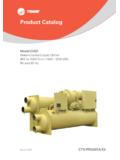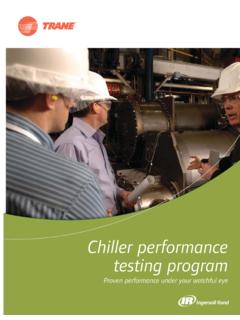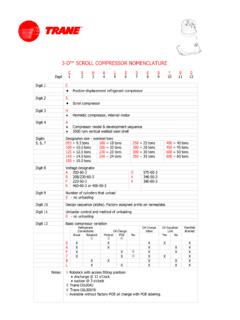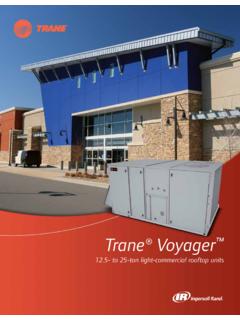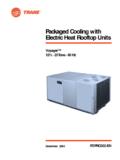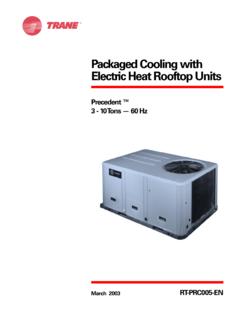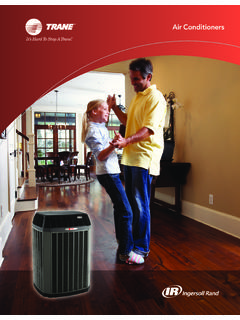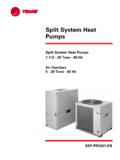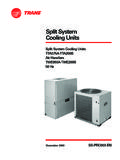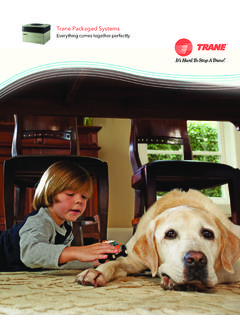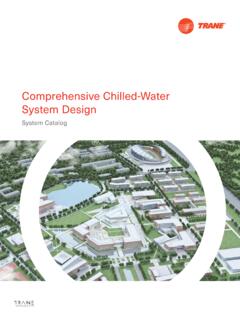Transcription of Water-side Heat Recovery - Trane
1 Providing insights for today s hvac system designer 2007 American Standard All rights reserved 1engineersvolume 36 1newsletterwater- side heat recoveryEverything old is new again!from the response to an energy crisis and an oil embargo, the 1970's was a decade during which design engineers recovered heat from the chiller 's condenser for use in other portions of the building or process. At that time Trane published a number of newsletters and manuals on heat and energy Recovery .[1] During the building booms of the 1980's and 1990's interest in energy waned -- hence heat Recovery was used energy costs have again increased, and environmental awareness has come to the industry forefront, use of energy Recovery has again increased.
2 (Airside energy Recovery was covered in ENEWS-29/5.)[2] Interest in heat Recovery from the condensers of water -cooled chillers has also increased. A problem is that many of the people who designed these systems during the 1970's and earlier are retired, so there is unfamiliarity with the systems. This newsletter gives information that should help the engineer properly select equipment, as well as design system configurations and controls to ensure efficient is energy recovered?In any cooling system, heat is transferred from the load location whether the load is a result of space temperature conditioning, dehumidification, or a process.
3 When air conditioning equipment is providing this cooling, several subprocesses are involved: heat is removed from either the space or the process by the evaporator or the chilled- water coil. heat is transferred to a condenser during the refrigeration process. heat is transferred from the condenser to the outdoor air-cooled systems, heat is generally transferred directly to the outdoor water -cooled systems, the heat is first transferred to a cooling tower, then to the outdoor alternative for water -cooled systems is to recover the heat , rather than rejecting it through the cooling tower.
4 This is the focus of this interest due Costs. In order to efficiently recover heat , there must be simultaneous heating and cooling than paying to reject heat , building owners can recover heat . This gives a double benefit: Recovered heat reduces purchased heat (and cost) and also reduces the ancillary power necessary to reject the heat . There are also non-economic reasons for utilizing heat Codes. Some standards and building codes require condenser- water heat Recovery for service water heating (see sidebar). A few applications that meet these criteria are hotels, dormitories, hospitals, correctional facilities, and high-rise condominiums with central-cooling addition to code requirements, specific building owners may decide to mandate the standard's use.
5 For example, the Army Corps of Engineers publication Humidity Controlfor Barracks and Dormitories in Humid Areas states:"..Army shall use condenser heat Recovery in accordance with ASHRAE "[3]ASHRAE/IESNA : heat Recovery for Service water Condenser heat Recovery systems shall be installed for heating or preheating of service hot water provided all of the following are true:(a)The facility operates 24 hours a day.(b) The total installed heat rejection capacity of the water -cooled systems exceeds 6,000,000 Btu/h (1,760 kW) of heat rejection.
6 *(c) The design service- water heating load exceeds 1,000,000 Btu/h (290 kW). The required heat Recovery system shall have the capacity to provide the smaller of:(a) 60% of the peak heat -rejection load at design conditions, or(b) Preheat of the peak service hot- water draw to 85 F ( C).Exceptions to :(a) Facilities that employ condenser heat Recovery for space heating with a heat Recovery design exceeding 30% of the peak water -cooled condenser load at design conditions.(b) Facilities that provide 60% of their service water heating from site solar or site recovered energy or from other (a) allows heat Recovery for space heating.
7 [4]*Editor s note: This is about 450 tons (1,580 kWR) of Trane Engineers Newsletter volume 36 1providing insights for today s HVAC system designerReduced Environmental Emissions. Energy Recovery is often considered a sustainable technology. In fact, the Green Building Council's (USGBC) Leadership in Energy and Environmental Design (LEED ) New Construction (NC) version document requires, as a prerequisite, compliance with ASHRAE Some building owners perform energy Recovery not only to reduce operating costs, but also to reduce emissions to the environment.
8 Lowering emissions is beneficial for a variety of reasons, including the following:Burning fossil fuels, such as natural gas, increases site emissions. If the job site has already reached the maximum emissions level allowed, recovering heat can satisfy future loads without consuming more fuel on site. This was the case cited by Ralph Cohen in his ASHRAE Journal article "Energy Efficiency for Semiconductor Manufacturing Facilities."[5]In addition, some locales are considering emissions trading. If such legislation becomes common, trading the emissions credits may be extremely analysis of heat - Recovery systems is critical.
9 Often there is the temptation to use methods such as Equivalent Full-Load Hours (EQFH) or bin analysis. These methods are too simple, especially when applied to heat - Recovery systems. The EQFH method ignores part-load operation of chillers and does not account for simultaneous heating and cooling loads. Bin analyses typically relate load and chiller operation to a particular ambient condition. With internal and solar loads being a significant portion of building load, and the fact that most chilled- water plants employ multiple chillers, the bin-analysis methods are rarely program capabilities to consider when using any analysis tool to examine heat Recovery include: Calculate coincident cooling and heating loads.
10 Account for various fuels (for example, so that systems with electric chillers and natural-gas boilers can be modeled). Model diverse utility rates, as they may include time-of-day usage and demand charges. Accurately model chiller heat - Recovery conditions and energy usage. Model system configurations (discussed later) that are used in heat - Recovery applications. If emissions reduction is important, the analysis tool should be able to show reductions in substances such as CO2, NOx (nitrogen-oxygen compounds), and SO2 when comparing the heat - Recovery alternative with other tools that fulfill these requirements include: System Analyzer and Trace 700 chiller Plant Analyzer: used for high-level scoping analyses.
